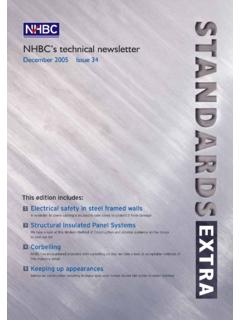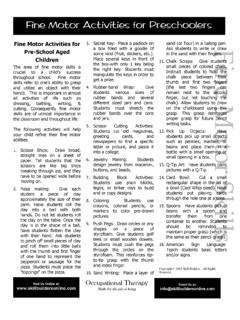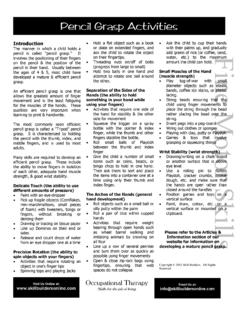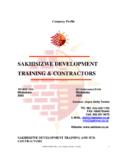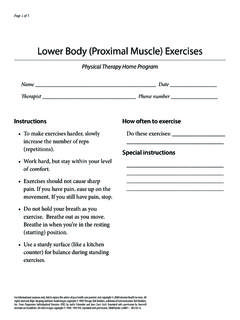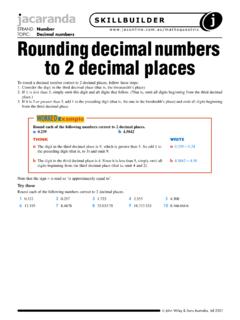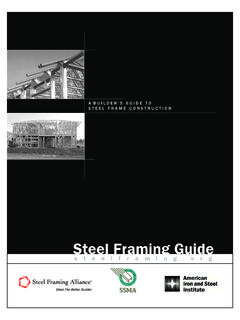Transcription of EVIDENCE OF MECHANICAL VENTILATION FLOW …
1 BUILDING REGULATIONS GUIDANCE NOTE NHBC BUILDING CONTROLEVIDENCE OF MECHANICAL VENTILATION FLOW RATE testing - testing OF FIXED AXIAL FANSR egulation 42 of the Building Regulations 2010 requires builders to provide EVIDENCE of the testing of all fixed fans to the Building Control Body (BCB) within 5 days of the test being carried out. The Domestic VENTILATION Compliance Guide (DVCG) published in 2010 gives the approved procedures for measuring air flows and reporting the results for Systems 1 to 4 described in Approved Document F 2010. However, following the procedure for testing System 1 axial fixed fans using a vane anemometer has presented practical challenges.
2 In particular, it has been shown that the resistance of the testing equipment can adversely affect the test results, to the extent that a compliant fan may appear not to meet the recommended extract VENTILATION rates in Table of Approved Document F. Builders have also found the description of the procedure to be have been working with industry and the Department of Communities and Local Government (DCLG) to devise a solution to these issues to allow accurate testing and reporting of fixed fans to be undertaken for all new ISSUESThe key issues are: n Methodology The DVCG notes that the most common method for testing fixed fans is using a vane anemometer, or similar, placed in a hood covering the terminal.
3 Although not intended by DCLG, terminal has been interpreted by some as meaning the termination point of the fan, which can be difficult to access as it is likely to be outside the building at high level or at the ridge in the case of a roof Presentation of Results Vane anemometers place a restriction on the airflow of the fan and the result can often be less than the rated output of the fan itself, especially if an axial fan is being guidance note describes three methods which builders can follow to test, record and report the testing of fixed fans in order to demonstrate compliance with the requirements to satisfy the BCB and discharge their obligations under Regulation 42.
4 The first two are only covered briefly as detailed guidance on these methods can be found in the BSRIA Document Domestic VENTILATION Systems A guide to measuring airflow rates . The third method uses the vane anemometer described in the DVCG. This note provides guidance on interpreting the results in the absence of the information on the fan output or performance curve required for Method Location In the majority of all cases the testing of fixed fans should be carried out at the terminal point within the room served by the the VENTILATION to a kitchen is provided via a cooker hood it may not be possible to carry out the test at the terminal point in the kitchen.
5 In this case it may be reasonable to carry out the test on the outside of the dwelling, provided it can be done so safely or if it is not, for example if it is above ground floor level, it would be reasonable for the BCB to take a view on compliance depending on the performance of the remaining fans in the of Equipment All testing equipment used should be correctly calibrated annually at a UKAS accredited laboratory. The information relating to the calibration should be entered onto the results sheet and should be available for the BCB if Methods Any of these methods can be used to show compliance and the method used along with any additional information required to verify the result should be indicated on the results further advice, please contact an NHBC surveyor on 0844 633 1000 and ask for Building Control.
6 Method 1 The Unconditional Method This measurement method uses a power flow hood which eliminates back pressure and places no additional restrictions on the fans being tested. The results shown on the equipment can therefore be taken as the correct performance of the 2 The Conditional Method This method allows a wide variety of testing equipment to be used including rotating vane anemometers, air capture hoods, thermal anemometers; thermal capture hoods, differential pressure anemometers and pressure the fan is tested, the reading is adjusted using a conversion factor specific to the fan make and model and the type of equipment being used.
7 The conversion factors must be provided by the fan manufacturer and be based on third party testing by a UKAS accredited body. Copies of the results should be made available on request. It is important that the correct conversion factors are used and must in all cases be specific to the installed record sheet needs to be completed with the following information n Fan make and modeln Test equipmentn Required outputn Measured outputn Specific conversion factorn Adjusted outputMethod 3 Minimum Benchmark Method This method can be used where the equipment in Method 1 is unavailable or the installed fan does not have the required conversion factors or performance curves required to adjust the measured results achieved with Method 2.
8 The test procedure is carried out as Method 1 and 2 using a vane anemometer fitted with a hood such as the one shown in Diagram 2. Minimum benchmark levels have been set which factor the impact of the test equipment. If the fan performance exceeds the minimum benchmark value indicated in Table 1 it would be reasonable for BCB to assume that the fan is performing to the required level and accept the test results as showing compliance with Part F of the Building the results fall below the minimum benchmark values the following options are open to the builder n Check the installation has been carried out in accordance with the manufacturer s recommendations.
9 That the correct rating of fan has been used and that there are no blockages or restrictions within any If the installation can be verified as being in accordance with the manufacturers recommendations the builder can retest the fans using Method 1 or 2 as these provide a more accurate means of measuring fan should be noted that the presentation of results for any of the three methods described does not necessarily guarantee compliance. BCB should use professional skill and judgement in ascertaining if an installation has been carried out correctly and in gauging if additional investigation is OF MECHANICAL VENTILATION FLOW RATE testing - testing OF FIXED FANSD iagram 2 Vane anemometer fitted with a hoodFor further advice, please contact an NHBC surveyor on 0844 633 1000 and ask for Building Control.
10 Diagram 1 Power flow hoodTable 1 minimum benchmark valueTABLE OF FAN RATING PERFORMANCEFan ratingMinimum benchmark performance15 l/s12 l/s30 l/s24 l/s60 l/s35 l/sEVIDENCE OF MECHANICAL VENTILATION FLOW RATE testing - testing OF FIXED FANSFor further advice, please contact an NHBC surveyor on 0844 633 1000 and ask for Building Control .AIR FLOW MEASUREMENT (FIXED SYSTEM 1 FANS ONLY)CustomerDwelling addressTest dateTEST EQUIPMENTAir flow measurement equipment used (Please state model and type)Date of UKAS calibrationCertificate method usedTickPlease refer to NHBC Guidance Note for further information on MethodsMethod 1 - unconditional methodComplete boxes (a), (b), (c), (d), (g) and (h)Method 2 - conditional methodComplete boxes (a), (b), (c), (d), (e), (f), (g) and (h)Method 3 - minimum benchmark methodComplete boxes (a), (b), (c), (d), (g) and (h) (15 l/s = 12 l/s), (30 l/s = 24 l/s) or (60 l/s = 35 l/s)




